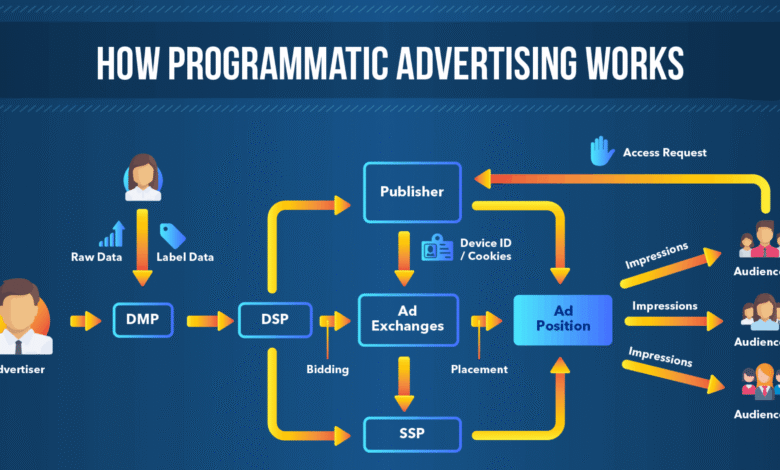What Is Programmatic Advertising

Table of Contents
Introduction
Programmatic advertising is changing the way businesses connect with their audiences in the digital world. Instead of relying on traditional methods—like direct negotiations, manual placements, or fixed ad buys—programmatic uses automated systems, data, and artificial intelligence to deliver ads in real time. This means marketers can reach the right audience, at the right time, with the right message, all while reducing wasted ad spend.
In today’s fast-paced environment, consumers are constantly switching between devices, apps, and platforms. Capturing attention in this fragmented landscape requires speed and precision that manual ad buying simply can’t provide. That’s where programmatic advertising comes in. It allows brands to make smarter decisions, optimize campaigns continuously, and scale efficiently across multiple channels.
This article will guide you through what programmatic advertising is, how it works, its benefits, challenges, best practices, and the trends shaping its future—giving you a complete understanding of why it’s so important today.
What Is Programmatic Advertising?
Programmatic advertising is the automated buying and selling of digital ad space using software and algorithms. Instead of humans negotiating deals, machines handle the process, powered by real-time bidding and audience data. This ensures that ads are shown to users who are most likely to engage, while advertisers spend their budgets more effectively.
The key difference between programmatic and traditional advertising is automation. Traditional advertising often requires contracts, phone calls, and upfront deals. Programmatic replaces this with software that decides, in milliseconds, where and when ads should appear.
The Core Components of Programmatic Advertising
To understand how programmatic works, it’s important to know its ecosystem:
- Demand-Side Platforms (DSPs)
Advertisers use DSPs to purchase ad inventory automatically. Through a DSP, they set budgets, target audiences, and upload creatives. - Supply-Side Platforms (SSPs)
Publishers use SSPs to make their available ad space accessible to advertisers. SSPs help maximize revenue by connecting publishers with multiple buyers. - Ad Exchanges
These are marketplaces where advertisers and publishers meet. They facilitate real-time auctions for ad placements. - Data Management Platforms (DMPs)
Data powers programmatic. DMPs collect, store, and analyze audience data so advertisers can target more precisely. - Dynamic Creative Optimization (DCO)
Ads can be automatically tailored to each user—for example, changing images, calls to action, or offers based on user behavior.
How Programmatic Advertising Works
Here’s a simplified step-by-step process:
- A user visits a website or app that has ad space.
- The publisher’s SSP sends a bid request to the ad exchange.
- Advertisers using DSPs evaluate the request, checking if the user fits their targeting criteria.
- Advertisers place bids in real time for that impression.
- The highest bid wins, and the ad is displayed instantly.
- Performance data—like clicks, views, or conversions—is tracked and fed back for optimization.
All of this happens in the blink of an eye, often within 100 milliseconds.
Benefits of Programmatic Advertising
- Efficiency at scale: Reach millions of users across different platforms without manual negotiation.
- Better targeting: Use demographics, interests, location, and behavior to reach the most relevant audience.
- Real-time optimization: Campaigns automatically adjust to improve performance.
- Cost effectiveness: Advertisers only pay for impressions that matter, minimizing waste.
- Cross-channel reach: Run ads across mobile, desktop, video, audio, and connected TV seamlessly.
Challenges and Risks
While powerful, programmatic advertising has its challenges:
- Ad fraud: Fake impressions and clicks can waste budgets.
- Brand safety: Ads may appear next to inappropriate or low-quality content without proper safeguards.
- Data privacy: Compliance with laws like GDPR and CCPA is essential.
- Complexity: Multiple platforms, tools, and metrics can make programmatic difficult for beginners.
- Transparency issues: Advertisers don’t always know exactly where their money is going.
Best Practices for Success
- Set clear goals: Define what success means—whether it’s awareness, clicks, or conversions.
- Leverage first-party data: Use your own customer insights to target audiences accurately.
- Experiment with creatives: Test multiple versions of ads to avoid fatigue and improve engagement.
- Prioritize brand safety: Use whitelists, blacklists, and verification tools.
- Monitor performance: Track metrics like CTR, CPA, and ROI to make informed adjustments.
- Stay compliant: Ensure all targeting and data use respect user privacy laws.
Trends Shaping Programmatic Advertising
- Connected TV (CTV): Streaming services and smart TVs are opening new inventory for programmatic buying.
- Contextual targeting: With cookies disappearing, advertisers are turning to page content and environment rather than personal data.
- AI and machine learning: Smarter algorithms are improving targeting accuracy and bid strategies.
- Private marketplaces: Brands are increasingly working directly with premium publishers for better control.
- Omnichannel campaigns: Programmatic now covers display, video, audio, native, and even digital out-of-home.
Programmatic Advertising and EEAT
Programmatic advertising is not just about automation; it’s also about trust and credibility. Aligning with EEAT principles ensures ads are effective and responsible:
- Experience: Ads should reflect genuine brand expertise.
- Expertise: Targeted content should demonstrate authority in the subject.
- Authoritativeness: Partnerships with reputable publishers boost credibility.
- Trustworthiness: Respecting privacy and ensuring brand safety builds long-term trust.
Read More: Digital Marketing in 2025: Strategies
Conclusion
Programmatic advertising has redefined how businesses approach digital marketing. By replacing manual processes with automated, data-driven systems, it enables advertisers to reach the right audience at the right time with unprecedented precision. Its benefits—efficiency, scalability, and real-time optimization—make it a powerful tool for maximizing return on investment.
Yet, programmatic is not without its challenges. Issues like ad fraud, brand safety, and privacy compliance mean advertisers must approach it thoughtfully. The most successful campaigns combine technology with strategy: using clean data, prioritizing trust, testing creatives, and monitoring performance.
As consumer expectations rise and regulations tighten, programmatic advertising will continue evolving. From connected TV to contextual targeting, its future lies in balancing innovation with responsibility. Businesses that embrace programmatic while staying user-focused, transparent, and ethical will not only improve performance but also build lasting relationships with their audiences.
FAQs
1. How does real-time bidding (RTB) work?
RTB is the auction system behind programmatic advertising. When a user loads a page, advertisers bid for the chance to show their ad, and the highest bidder wins—all within milliseconds.
2. What types of ads can be run programmatically?
Programmatic supports display banners, video ads, mobile ads, native advertising, audio ads, and even connected TV placements.
3. How much does programmatic advertising cost?
Costs vary depending on audience targeting, competition, and format. Advertisers often pay using CPM (cost per thousand impressions) or CPA (cost per acquisition).
4. Is programmatic advertising safe for brands?
Yes—if safeguards are in place. Using brand safety tools, verified publishers, and careful monitoring reduces risks of poor ad placement.
5. How does programmatic handle user privacy?
Modern platforms must comply with data laws like GDPR and CCPA. Many advertisers are shifting to contextual targeting to reduce reliance on personal data.



